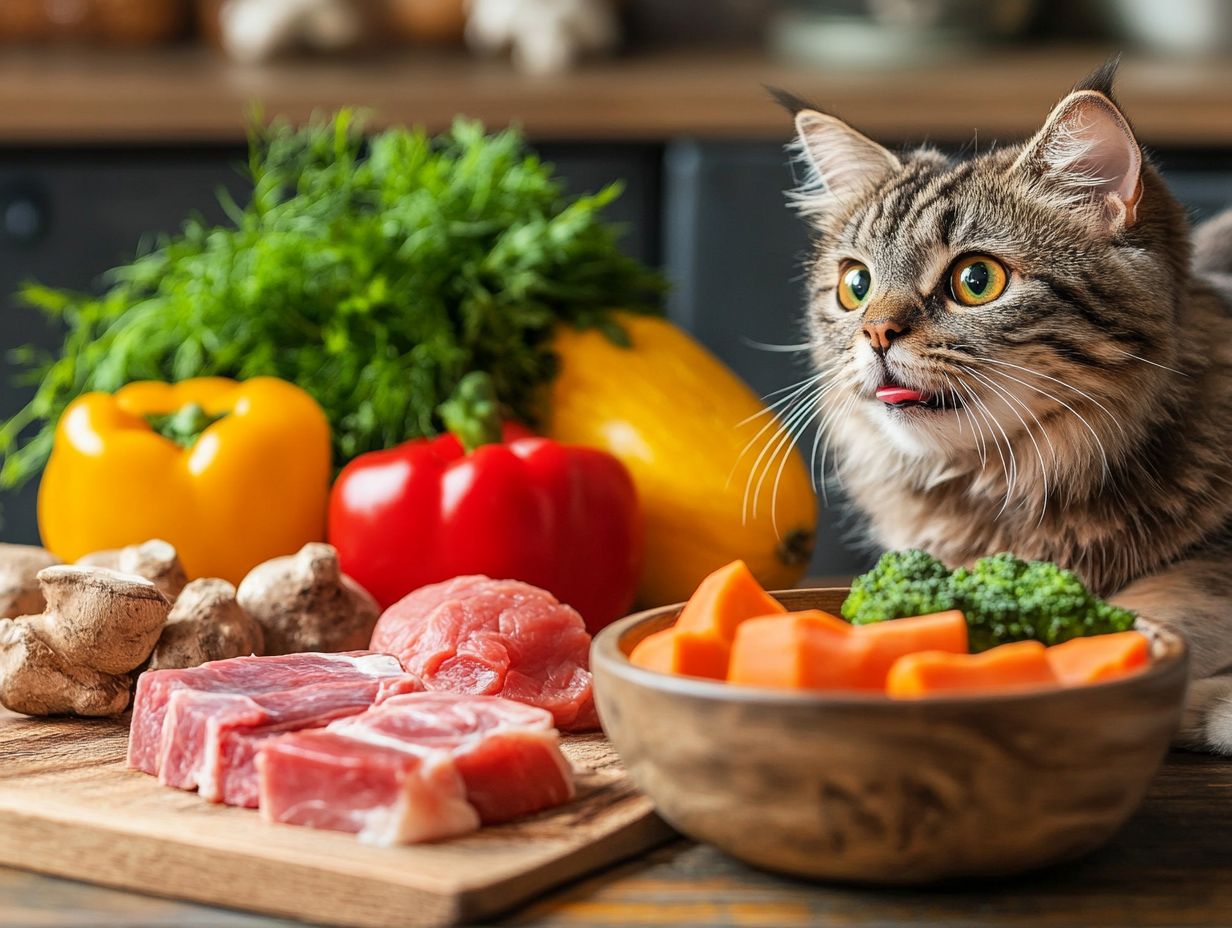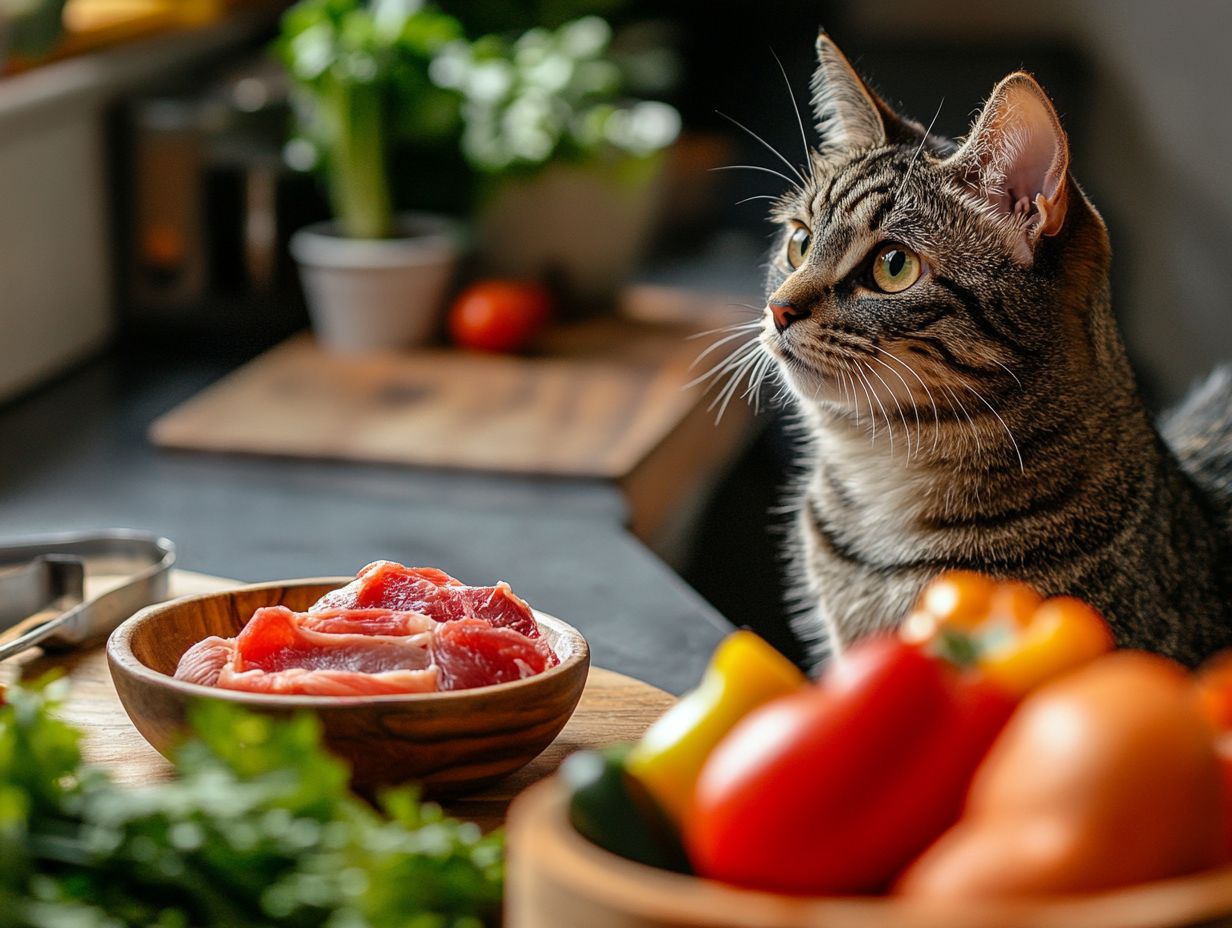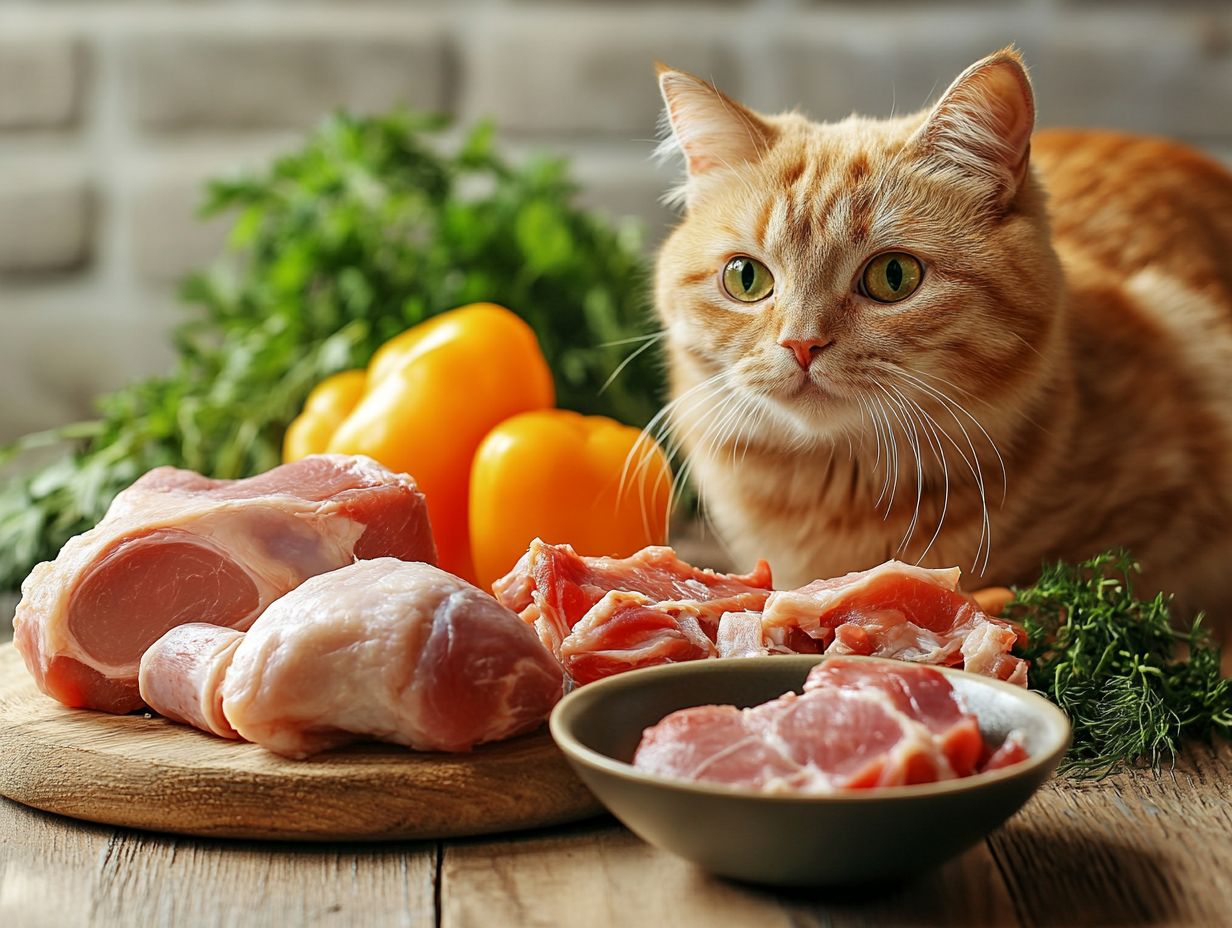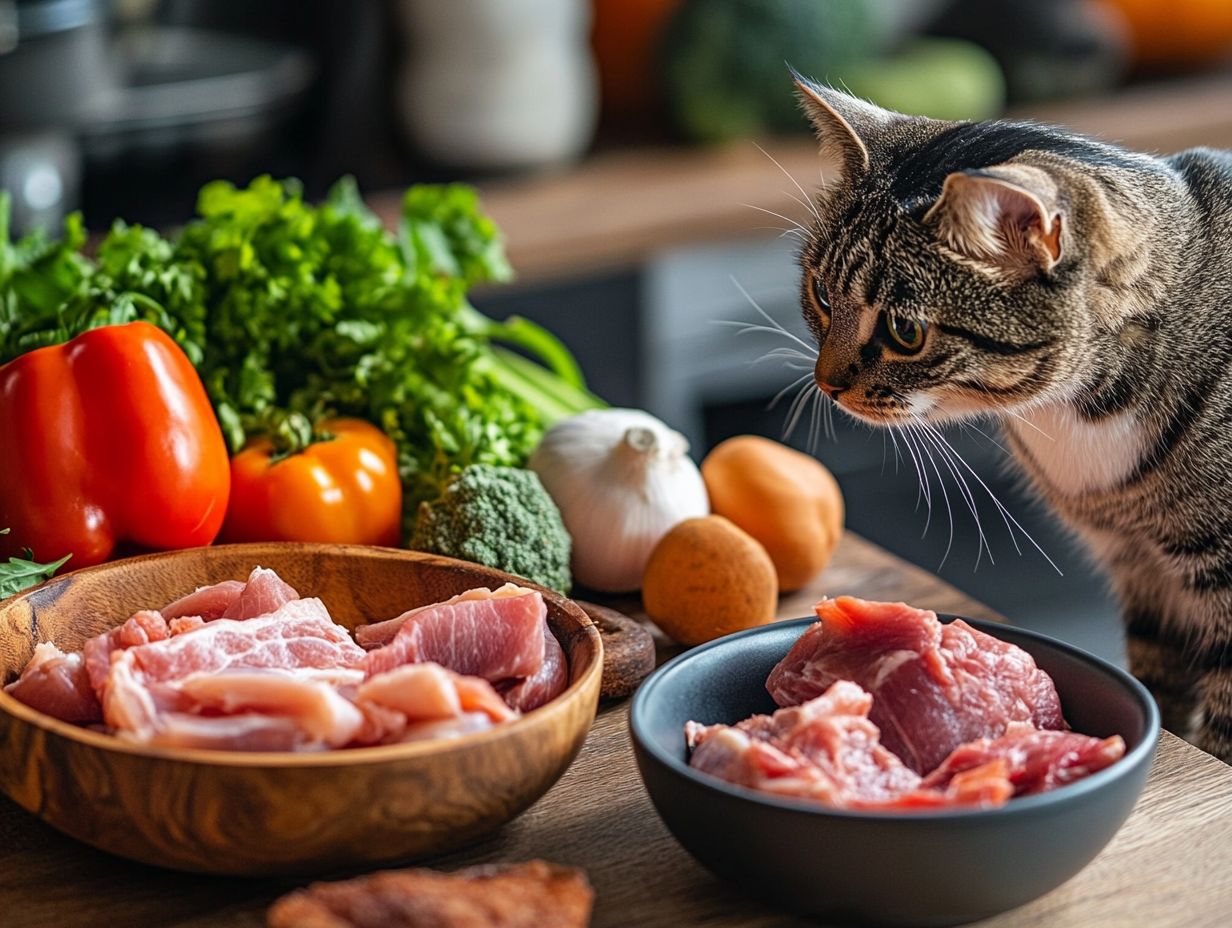If you’re considering a raw cat food diet for your feline friend, you’re not alone. Some cat owners are exploring this approach, driven by the idea of mimicking a cat’s natural diet and providing potential health benefits. Raw feeding has gained attention among some cat owners as they seek to provide complete nutrition and hydration benefits for their cats.
It’s essential to weigh the advantages against the risks, such as bacterial contamination, nutritional imbalances, and foodborne pathogens. Consulting with a veterinarian can provide balanced advice.
This article will guide you through the reasons to consider a raw diet, how to safely transition your cat to a raw diet, and what to include for optimal health, emphasizing adherence to AAFCO guidelines and safe handling practices.
Join us as we explore everything you need to know for your cat’s well-being, covering both the benefits and risks of feeding raw diets.
Key Takeaways:

Why Should You Consider a Raw Cat Food Diet?
A raw cat food diet offers numerous advantages for cats, closely resembling their natural eating habits. It can help address nutritional deficiencies that can occur in poorly formulated commercial diets. Premium raw food options provide balanced recipes to fulfill the dietary requirements of cats.
The high protein content and comprehensive nutrition of raw cat foods have been shown to support overall feline health. By using high-quality ingredients, such as animal tissue, commercial raw cat foods can promote a cat’s well-being through balanced recipes that fulfill their taurine requirements and hydration needs. Adhering to feeding guidelines for high dietary protein ensures optimal health benefits.
1. Mimics a Cat’s Natural Diet
A raw cat food diet closely mimics the natural dietary habits of cats, consisting primarily of high-quality protein sources such as uncooked meat and animal tissue, which are essential for their survival and health. This evolution of a cat’s diet highlights the importance of protein as a fundamental component of their nutritional needs.
Unlike omnivorous pets, felines thrive on a meat-based diet that provides vital amino acids necessary for optimal bodily function. Over time, as domesticated cats have evolved, their dietary requirements have remained largely consistent with those of their wild ancestors.
Following the guidelines set by the Association of American Feed Control Officials (AAFCO), a well-formulated raw diet can effectively meet these needs, ensuring the availability of essential nutrients. Incorporating raw diets can lead to healthier skin, a shinier coat, improved digestion, and enhanced dental health, making it a compelling choice for cat owners who prioritize their feline’s well-being.
2. Provides Essential Nutrients
Feeding raw cat food ensures that essential nutrients, including amino acids and specific vitamins that may be lacking in standard commercial diets, are provided. This approach meets important requirements for taurine, which is vital for heart and vision health, as well as other essential needs that may not be fully addressed. The use of premium ingredients can further enhance the diet’s nutritional value.
Incorporating organ meats, such as hearts and livers, offers a variety of nutrients and helps fulfill the overall requirement for both known and unknown fatty acids. It is crucial to use balanced recipes to avoid deficiencies or excesses that could arise from a strictly raw diet. Additionally, supplementation with vitamins, such as B12 and omega-3 fatty acids, can enhance the nutritional content. Consulting a veterinary nutritionist can help ensure nutritional adequacy.
Proper recipes and adequate supplementation can together create a holistic diet for cats, while also emphasizing allergy safety and the identification of toxic ingredients that could be included in homemade raw diets.
3. May Improve Digestion
When transitioning to a raw diet, it is important to follow practical steps and timelines for the safe implementation of the new diet. Additionally, owners should be cautious about the risks of feeding raw diets to cats with specific health conditions, such as kidney disease or diabetes, stressing the need for veterinary consultation to ensure the diet is appropriate.
Proper food storage and handling practices are essential to prevent spoilage and contamination, further ensuring the safety and health of your feline friend.
Finally, it is crucial to ensure that all dietary recommendations reflect current guidelines from authoritative bodies like AAFCO and WSAVA, with specific references provided where possible.
One of the key benefits of a raw cat food diet is improved digestive health, as supported by current scientific studies. This diet typically provides high moisture content and natural raw ingredients, which promote better nutrient absorption and help minimize common digestive issues.
As a result, it often leads to a more balanced intake of essential vitamins and minerals, fostering optimal energy levels and overall feline health. The raw ingredients primarily consist of fresh meats, as cats are obligate carnivores and require animal-source proteins for their nutritional needs. Appropriate plant-based ingredients may be included for fiber, but they should not be viewed as significant contributors to nutrition.
Adhering to safe handling and food safety practices can further enhance the benefits of a raw diet. Specific guidelines include:
- Storing raw meat at temperatures below 40°F (4°C)
- Using airtight containers
- Properly cleaning surfaces and utensils
- Avoiding cross-contamination with other foods
This can lead to fewer gastrointestinal disturbances, such as bloating or diarrhea. Scientific studies suggest that a raw food regimen encourages the development of beneficial gut bacteria, further enhancing digestion and nutrient uptake.
Consequently, the overall quality of life for cats on a raw diet can be significantly improved. The inclusion of premium raw food options can optimize protein efficiency and nutrient absorption.
What Are the Risks of a Raw Cat Food Diet?
A raw cat food diet offers significant advantages; however, pet owners must also be aware of the associated risks. These include raw meat risks and dietary concerns that necessitate responsible feeding practices.
These include the potential transmission of bacterial pathogens such as Salmonella and E. Coli, which can have serious health implications for both cats and humans. Pet owners should learn how to identify signs of spoilage in raw meat, such as off odors or discoloration, to avoid feeding potentially harmful food.
1. Bacterial Contamination
Bacterial contamination poses a significant risk with raw cat food, as uncooked meat often harbors pathogens such as Salmonella and E. Coli, which can be harmful to both cats and their human families. These harmful organisms can lead to serious illnesses in both pets and people, making it essential for pet owners to adhere to strict food safety practices when preparing and serving raw diets. Implementing high pressure processing (HPP) can help reduce the prevalence of bacterial pathogens.
Sourcing food from reputable suppliers and ensuring that fresh meat meets safety standards can help mitigate the risks associated with bacterial proliferation. Proper handling procedures include:
- washing hands
- using sanitized surfaces
- avoiding cross-contamination with other foods
Additionally, storage requires maintaining the appropriate temperatures for raw meat and using airtight containers to limit bacterial exposure while preserving the quality of the food.
2. Nutritional Imbalances

Raw cat food diets can lead to nutritional imbalances if not properly formulated, as they may lack essential vitamins and minerals, such as taurine, which is crucial for overall feline health. Consulting with a veterinary nutritionist and the Feline Nutrition Foundation is vital in this regard.
These experts can help create custom recipes tailored to a cat’s specific dietary needs, ensuring a balanced combination of proteins, fats, and carbohydrates. Without expert guidance, deficiencies can easily arise, potentially resulting in serious health issues such as weakened immunity, poor coat condition, or even organ dysfunction. The use of vitamin supplements should be discussed with a veterinarian, as not all cats may require them.
It is essential for pet owners to incorporate scientifically-backed insights into their feeding regimens to prevent nutrient shortfalls. Regularly evaluating the cat’s health and adjusting the diet as necessary, especially for life stages like kittens, seniors, or pregnant/nursing cats, is also crucial.
3. Bones and Choking Hazards
The bones found in raw cat food diets can pose a potential choking hazard and may cause internal trauma if not chosen and managed carefully. These risks underscore the importance of caution when incorporating bones into a cat’s diet.
Owners should consider the size, type, and preparation of the raw ingredients they select, as certain bones can splinter and lead to serious intestinal damage, while others may cause choking if they are not appropriate for the cat’s size. It is advisable to use softer bones that are less likely to splinter and to closely monitor feeding times. Understanding the risk factors associated with raw feeding is essential for responsible pet owners.
Before transitioning to a raw diet, it is recommended to consult with a veterinarian to tailor the diet to the specific health conditions of cats, such as kidney disease or diabetes.
Grinding the bone or using bone meal can provide the same nutritional benefits without the associated risks, making these practices essential for responsible pet owners who prioritize pet food safety. However, it is crucial to ensure these practices are safe and compliant with veterinary nutritional standards, as raw bone consumption can pose risks of injury or bacterial contamination.
How to Transition Your Cat to a Raw Food Diet
To transition your cat to a raw food diet, it is important to do so gradually. This approach will help your cat adjust to the new diet without experiencing digestive upset, stress, or nutritional deficiencies. Following biologically appropriate raw food (BARF) diet principles can ease the transition process.
1. Start Slowly
It is crucial to start the transition to a raw cat food diet slowly to prevent digestive upset and to allow for proper adaptation to the new diet. The transition should be gradual, allowing the cat’s digestive system to acclimate to the new nutrients and textures.
Begin by mixing a small amount of raw food with their regular diet, gradually increasing the portion of raw food over time as the cat becomes accustomed to the taste and texture. This gradual approach aligns with USDA feeding guidelines and helps reduce the risk of nutritional deficiencies.
During this transition, it is important to monitor the cat’s reactions for any signs of discomfort and changes in stool consistency. Additionally, observing their energy levels and overall mood can help indicate how well they are adapting to the new diet and whether they are enjoying it. Utilizing high dietary protein sources can aid in a smoother transition.
2. Gradually Increase Raw Food Portions
Gradually increasing the raw food portions helps avoid digestive issues and supports overall digestive health.
To ensure your cat successfully adapts to a raw food diet, you should gradually increase their raw food portions until you reach a balanced amount that supports their overall health. Adhering to transitioning cats guidelines can help minimize digestive issues.
During this transition period, it’s important to monitor them closely, as some cats have sensitive stomachs that may react to the new food in various ways, ranging from mild tummy aches to more serious issues. Introducing the new diet incrementally and in small portions allows your cat to adjust to each change comfortably. Using quality ingredients can further ease the adjustment process.
Changes in their behavior and stool consistency can provide insight into how well they are adapting. Be sure to adjust portions based on their specific dietary needs, including age, weight, and energy levels. Additionally, consider their personal food preferences, while avoiding any toxic or harmful foods such as onions and garlic, as some cats may favor certain proteins or textures, making the transition smoother. Incorporating high dietary protein from quality ingredients can enhance their adaptation to raw cat food.
3. Monitor Your Cat’s Health
Regularly monitoring your cat’s health during the transition to a raw food diet is essential to ensure they receive proper nutrition and avoid developing health issues. It is crucial to prioritize regular health checks and consult with a veterinary nutritionist before making significant dietary changes, especially for cats with existing health issues, to ensure the cat’s specific dietary needs are being met.
As a pet owner, you should be attentive to subtle changes in your cat, such as lethargy, alterations in coat quality, appetite loss, or other unusual behaviors, as these may indicate potential nutritional deficiencies. Additionally, tracking your cat’s food intake, weight changes, and litter box habits can provide valuable insights into their nutritional status.
Maintaining open communication with your veterinarian will facilitate prompt adjustments to optimize your cat’s health and well-being during this significant transition, considering raw feeding advantages and potential health concerns.
What Should Be Included in a Raw Cat Food Diet?
A well-balanced raw cat food diet should include high-quality protein sources, essential vitamins, and minerals to ensure that your cat receives complete nutrition and hydration benefits, both of which are vital for their health.
1. High-Quality Protein Sources

High-quality protein sources, such as animal tissue, form the foundation of a raw cat food diet, providing essential building blocks for your cat’s muscle development and overall health. Choosing premium ingredients ensures that your feline receives the vital amino acids necessary for optimal growth and repair, while also enhancing overall vitality and nutritional adequacy.
In addition to high protein, a balanced raw diet should also include adequate fats, vitamins, and minerals according to AAFCO recommendations. Some homemade recipes may require supplementation, so it is advisable to seek professional guidance on necessary supplements.
Ingredients like raw chicken, turkey, and fish are excellent options, as they offer diverse nutrient profiles tailored specifically to a cat’s dietary needs. Additionally, incorporating organ meats such as liver and kidneys can significantly enhance nutritional value due to their rich vitamin and mineral content. However, pet owners should consult with a veterinarian before making significant changes to their cat’s diet, especially regarding raw or homemade food, to address individual health needs.
This balanced approach to protein sourcing is crucial, as it establishes a strong foundation for a healthy immune system and optimal health and longevity, supporting their overall well-being.
2. Essential Vitamins and Minerals
Including essential vitamins and minerals in your cat’s raw food diet is crucial for their overall health and for ensuring that the diet is nutritionally adequate. Cats require a variety of nutrients, including vitamin A, B vitamins, taurine, and essential fatty acids. These nutrients are important for energy production, metabolic processes, proper eyesight, cardiovascular function, and maintaining a shiny coat. Ensuring nutritional adequacy is essential to meet AAFCO guidelines and WSAVA guidelines.
Many veterinarians recommend sourcing these nutrients from high-quality animal proteins, organ meats, and certain vegetables. It’s essential to clarify that raw diets can carry potential risks such as nutrient imbalances or pathogens; therefore, these diets should only be pursued with veterinary guidance. If supplementation is necessary, it is vital to do so carefully to prevent health issues arising from deficiencies or excessive amounts. Striking the right balance is essential to ensure that your cat receives everything it needs to thrive.
3. Healthy Fats
Healthy fats are essential components of balanced raw cat food recipes, enhancing both the nutritional profile and palatability of the diet. These healthy fats, sourced from various ingredients, serve as crucial building blocks for a cat’s energy needs and overall well-being.
Cold-pressed oils, such as fish oil and flaxseed oil, are rich in omega-3 and omega-6 fatty acids, which are vital for maintaining a healthy coat and skin. Additionally, incorporating small amounts of animal fat from organ meats can provide the necessary nutrients for cellular function and energy. Ensuring the moisture content of meals is also crucial for hydration.
By carefully combining these sources in meal plans, pet owners can ensure the proper nutrient ratios needed for their cat’s health and longevity. For different life stages, such as kittens, adults, and seniors, it is important to adjust the recommended percentages and types of animal proteins accordingly.
4. Optional Supplements
A well-prepared raw cat food diet should supply most of the essential nutrients your cat needs. In some cases, optional supplements may be beneficial for enhancing nutrient absorption or overall health. For instance, older cats or those with specific medical conditions might require additional vitamins or minerals that their diet does not adequately provide. Similarly, some cats may have dietary restrictions or sensitivities that hinder their ability to obtain necessary nutrition.
It is important to assess individual needs with the guidance of a veterinary nutritionist, who can help determine those requirements and recommend appropriate supplements, if necessary, to safely and effectively meet them. This personalized approach enables pet owners to ensure their cats receive a proper diet that supports longevity and enhances their quality of life. Additionally, it’s crucial to research and verify any new ingredients before introducing them, as there may be potential allergens and toxic ingredients in homemade diets.
How to Ensure Your Cat’s Raw Food Diet Is Safe
Taking proper precautions and handling measures against foodborne pathogens like Salmonella and E. Coli can significantly reduce the risk of raw food diets harming your cat’s health. Employing safe handling practices is essential for pet food safety.
1. Proper Handling and Storage
Proper handling and storage of raw cat food are essential for preventing contamination by foodborne pathogens, thus ensuring your cat’s health and safety. Understanding raw meat risks is key to maintaining food safety.
One of the most effective ways to prevent contamination is through temperature control; refrigeration at 40°F or below inhibits the growth of bacteria that cause foodborne illnesses. Always use separate utensils and cutting boards designated for raw ingredients, and ensure that they touch other foods only after thorough washing.
Additionally, raw cat food should be stored in airtight containers and consumed within a few days of thawing. By implementing these procedures, pet owners can enhance food safety, allowing them to provide nourishing meals while protecting their cats from potential hazards. It’s also important to be aware of signs of spoilage in raw cat food, including visual and olfactory cues.
2. Rotating Protein Sources
Rotating protein sources in a cat’s raw food diet not only increases nutritional value through enhanced vitamins and minerals, such as vitamin A and iron, but also reduces the likelihood of developing food allergies and food sensitivities, while maintaining their interest in food. This approach aligns with BALANCED RECIPES and supports protein efficiency.
Diversifying protein types provides a broader range of essential amino acids and nutrients necessary for overall health and well-being. Options such as chicken, turkey, fish, and beef can be introduced in a balanced manner and rotated on a weekly or bi-weekly basis to keep the diet engaging and nutritious.
Pet owners should carefully monitor their cats’ reactions to each new protein, as symptoms of discomfort may indicate an intolerance.
Gradual transitioning, while maintaining variety, can help encourage cats that maintain a balanced diet who enjoy their meals and have stable nutritional requirements.
3. Consulting with a Veterinarian

Consultation with a veterinarian or a veterinary nutritionist is essential when establishing a raw cat food diet, as they can help navigate specific dietary restrictions and provide the necessary guidance to address specific dietary concerns. Their expertise ensures that the diet meets the nutritional needs of the cat while prioritizing overall health and safety. They may recommend vitamin supplements, such as omega fatty acids or probiotics if needed, noting that excessive supplementation can pose risks.
By closely monitoring the cat’s health, these professionals can identify any potential deficiencies or imbalances and adjust the feeding plan accordingly. This professional oversight is particularly important, as a raw diet can have unintended consequences, such as bacterial contamination, if not properly managed.
For instance, they may recommend supplements or alternative food sources to ensure a balanced diet, ultimately contributing to the cat’s long and healthy life. It is crucial to avoid raw diets for immunocompromised cats or those with certain metabolic diseases, reinforcing the need for veterinary guidance in these cases.
Frequently Asked Questions
What is a raw cat food diet and how does it benefit my cat’s health?
A raw cat food diet is a diet that consists of uncooked, unprocessed meats, bones, and organs. This diet is biologically appropriate for cats and can improve their overall health by providing necessary nutrients and enzymes that may be lacking in commercial raw cat food or homemade raw food.
How do I transition my cat to a raw food diet?
To transition your cat to a raw food diet, start by gradually introducing small amounts of raw food mixed with their current diet. Slowly increase the amount of raw food and decrease the amount of their old food over a period of 10-14 days, as abrupt changes can lead to gastrointestinal upset.
Do I need to add supplements to my cat’s raw food diet?
A balanced raw food diet should provide all the necessary nutrients for your cat, so supplements are generally not needed. However, consulting with a veterinarian is recommended to ensure your cat is receiving all the necessary nutrients, particularly taurine requirements and adhering to feeding guidelines.
Can I feed my cat only raw food or should I mix it with other types of food?
A raw food diet can be the sole diet for your cat, but you can also mix it with other types of food if desired. It is important to consult with a veterinarian to ensure your cat is receiving a balanced diet.
Is a raw food diet safe for all cats?
A raw food diet is generally safe for all cats, but it is important to consult with a veterinarian before making any dietary changes. Some cats with pre-existing health conditions may not be suitable for a raw food diet. Monitoring for digestive issues is also a critical consideration for risk factors, particularly for pregnant or nursing cats, which may have different nutritional needs.
Can I make my own raw cat food at home or should I buy commercial raw cat food from a store?
You can make your own raw cat food at home, using high-quality ingredients and ensuring the inclusion of animal-source proteins and essential nutrients like taurine and amino acids, but it is important to properly research and follow a balanced recipe to avoid nutritional deficiencies. Alternatively, there are commercial raw cat food options available that are formulated specifically for feline nutrition and meet AAFCO guidelines, offering benefits such as hydration and proper protein sources. It’s crucial to consider food safety, such as safe handling of raw ingredients and awareness of foodborne pathogens like Salmonella and E. Coli. Consulting a veterinary nutritionist can help address dietary concerns and ensure complete nutrition for your cat.